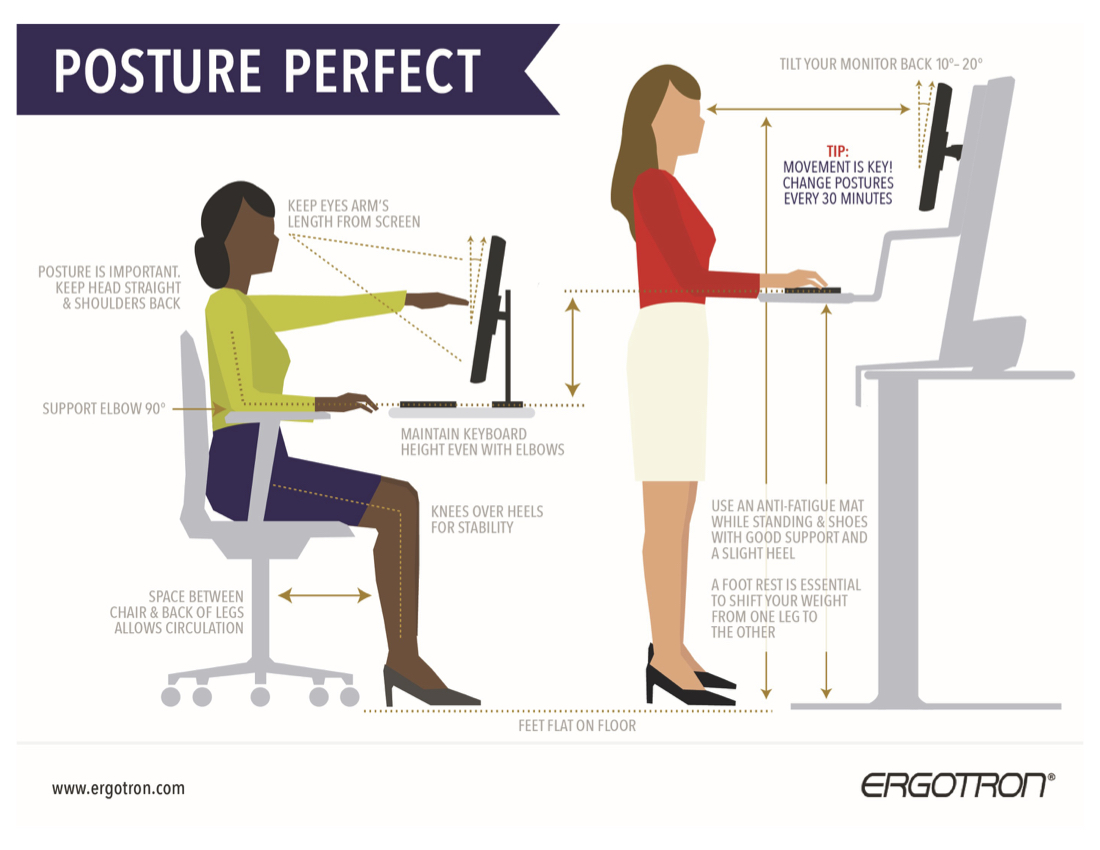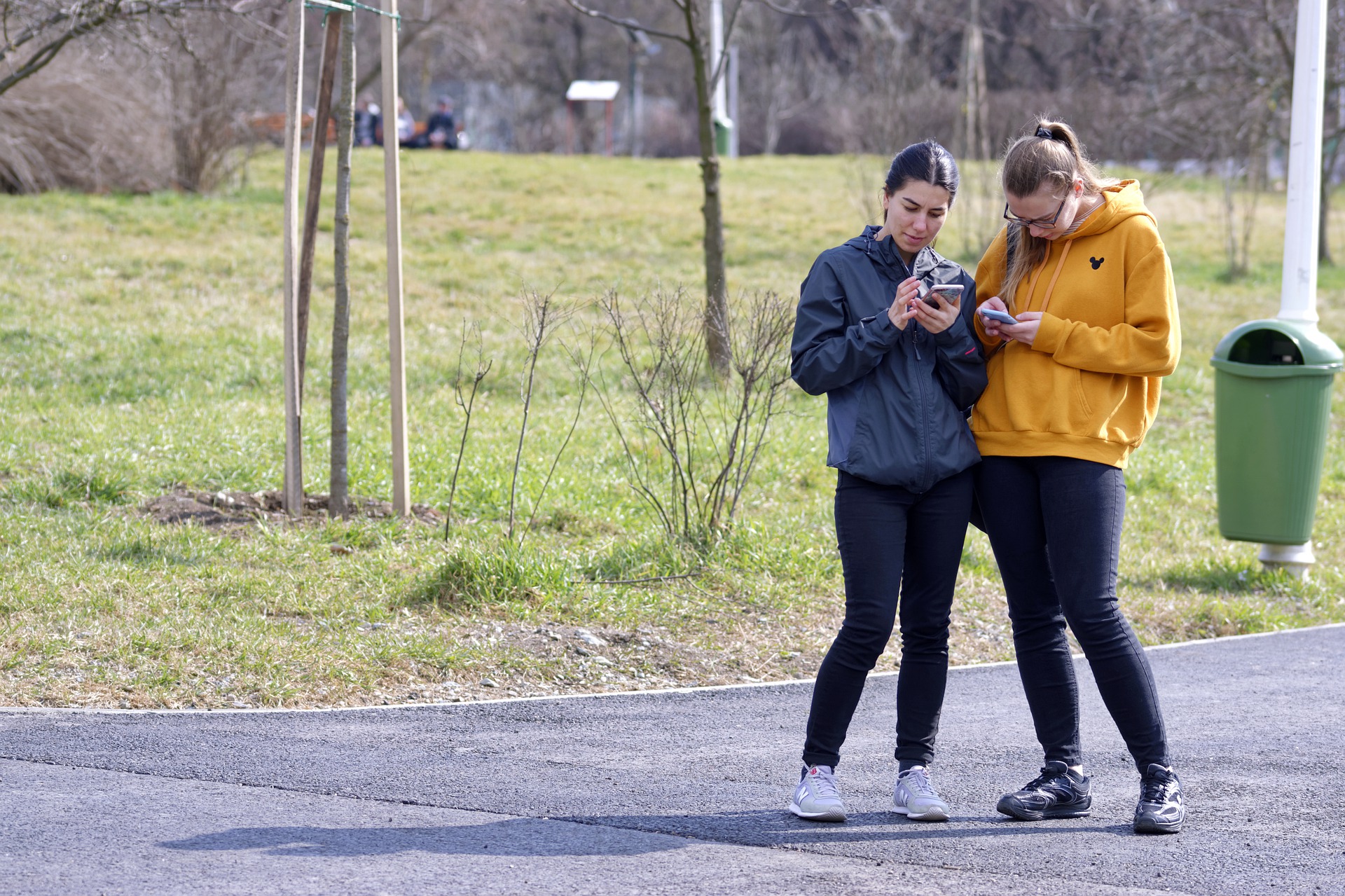Good posture used to be a serious issue, stressed both at school and in the home. Although those rigid standards have largely disappeared, we have again come to recognize the importance of good posture for many aspects of wellness, focus and success.
With multiple factors working against our posture in this modern world, we have come to rely on a variety of methods and products to help correct poor posture; while people in many traditional cultures maintain good posture naturally. Let’s look at what you have to gain from improving your posture, and habits you can adopt that will help you naturally achieve this goal.

What is good posture?
Good posture is a position in which your body is naturally balanced. In standing, sitting or walking, your spine is in the neutral position of its natural curvature, neither exaggerated nor flattened.
The head (a weight of 10 pounds or more) is comfortably balanced over the neck, with the chin parallel to the floor. This requires that the head and shoulders be held back much further than many of us are used to. Both hips, shoulders, elbows and knees are even. The abdominal muscles are tight, and your weight is evenly distributed.

While attempts to improve posture may feel uncomfortable and hard-to-maintain at first, once your muscles become accustomed to this position, it will become easier and feel more natural.
Poor posture — causes and effects
Success
You are now signed up for our newsletter
Success
Check your email to complete sign up
Poor posture is any position where the spine is unbalanced — making movement less efficient, compromising the internal organs, and undermining your physical and mental health. There are many forms of poor posture that can lead to various maladies if not corrected.
Habits like looking down at a cell phone, carrying a heavy load on one shoulder, sitting for long periods without breaks, leaning towards your computer, or even wearing high heels can all contribute to spinal stress and poor posture.

The position of the spine impacts the circulatory, digestive, respiratory and nervous systems, affecting both physical and mental wellness alike. Poor posture can not only directly cause back pain and headaches; it can also lead to arthritic joints, constipation, restricted breathing, incontinence, muscle fatigue, spinal degeneration, depression and lack of focus or motivation.
Very few people have perfect posture, so you’re not alone if you’re a bit of a slouch; but consider the possibilities if you worked to improve your posture.
The many benefits of good posture
One of the most important benefits of proper posture is that it allows your internal organs to function properly. A natural and balanced spinal column can unlock energy and improve circulation and digestion; and without the rib cage constricting the lungs, you have a greater breathing capacity. Since the brain uses a full quarter of your body’s oxygen, this may explain another valuable benefit — that of increased cognition and memory.
Aches and pains are alleviated when the bones and joints are correctly aligned. Muscles are used with efficiency — reducing fatigue — and joint surfaces are not stressed by abnormal wear. Strain is minimized; and back pain, neck pain and headaches may disappear.

Good posture also improves your appearance, making you look both taller and slimmer. How many actors or models can you think of who slouch? It’s no secret that taller, fitter looking men are generally deemed more attractive by women; but research shows that they also earn more money than their shorter and portly counterparts.
It really is a recipe for success. Presenting yourself with good posture boosts self confidence, giving the impression of confidence to others, and bestowing you with an authoritative air. In addition, good posture has long been linked to good character.
A virtuous person is often described as being “upright,” and one who sticks to his principles is “standing tall.” It stands to reason that those with good posture are strict with themselves in many regards, which generally leads to a more productive and meaningful life.
Finally, whether as a result of the other benefits or as an isolated bonus, good posture adds to happiness. One study showed that slouching promoted the recollection of unhappy memories, while upright participants were more likely to remember joyous occasions.
Good posture is the norm in traditional cultures
Acupuncturist Esther Gokhale, in seeking relief for her own back pain, made a mission of observing the relationship between spinal health and the lifestyles of indigenous populations around the world. What she found was that the active traditional lifestyles naturally promoted strong abdominal muscles, good balance, and excellent posture.

Gokhale saw a clear difference between the shape of the typical American spine and the typical indigenous spine. “They have this regal posture, and it’s very compelling,” she said, noting that the profile of American spines form a fairly pronounced S-shape, while the indigenous spines are shaped more like a J. She added that ancient sculptures and artwork portray figures with J-shaped spines as well.
Rather than sitting in chairs, many indigenous peoples sit on a flat surface — the ground, a floor, or a mat. They use a number of squatting or kneeling positions to perform their daily activities, strengthening the core, and exhibiting flexibility that most westerners would marvel at. When carrying loads, they use their bodies efficiently with minimum strain; and when walking, which they do often, they flex and strengthen their gluteus medius muscles.
In short, the simple, yet purposeful lifestyle of traditional cultures — while not striving for comfort and ease — seems to achieve just that. Without working out at the gym or practicing yoga, back pain and other postural problems are virtually non-existent in this active-living environment.

Ancient Chinese proverb
In ancient China, good posture was valued as both a physical and spiritual attribute that reflected one’s strength and character. With the cultivation of character being so important in traditional Chinese culture, a proverb was expressly created to promote proper posture:
Stand like a pine
Sit like a bell
Walk like the wind
Lie like a bow
If you’ve ever examined Chinese written characters, you might guess that nothing is simple about the language. There are layers of meaning in almost everything, including this brief passage.
Stand Like a Pine
As an evergreen, the pine tree is symbolic of longevity, or eternity. It is also a valued source of lumber for its tall, straight form. Standing upright like a pine suggests both groundedness, and the noble aspiration of reaching toward heaven.
Sit Like a Bell
Like many traditional cultures, ancient China did not commonly make use of chairs. It was believed that being too comfortable jeopardized one’s focus. The bell, with its clear and harmonious sound, is symbolic of pure wisdom, and is used in China to communicate with spirits and deities.

Walk like the Wind
To move like the wind is generally taken to mean quickly, or rapidly. In China, the wind is an element strongly associated with power. Like many indigenous people, the Chinese traditionally moved with purpose and poise. To walk like the wind suggests one is light yet powerful.
Lie Like a Bow
While western physicians offer varied advice for sleeping positions, the ancient Chinese philosopher Confucius insisted that one should sleep on the side, relaxed and bent. Practitioners of traditional Chinese medicine agree that sleeping on the back or front could interrupt the qi, or energy flow in the body.
The bow is often seen as a symbol of cleansing and purification, qualities well-worth aiming towards during sleep.
Habits and simple exercises for improving posture
There are many ways one can improve posture naturally. Becoming aware of your deficiency is the first step toward correcting it. Then you can adopt habits that promote good posture and choose exercises that will strengthen the muscles needed to maintain it.
To attain the neutral spine position, Meghan Markowski, a physical therapist at Harvard-affiliated Brigham and Women’s Hospital, suggests: put the shoulders down and back, hold the head back, and “Bring your belly button in toward your spine, as if you’re zipping up a snug pair of jeans,” tightening the core muscles.
When seated, keep your chin parallel to the floor; your shoulders, hips, and knees at even heights; and your knees and feet pointing straight ahead. One can sit on the edge of a chair to experience the challenge of going “backless,” or use a lumbar support pillow to remind you not to slouch. Be sure to give yourself a break with some varied movement every 30 minutes or so to prevent fatigue.
Build abdominal strength with the seated knee lift. Sit erect on a chair with your feet hip-width apart and hands at the sides. Exhale as you lift the right knee and left hand upward. Inhale as you lower them and repeat 10 times. Then do the same with the left knee and right hand.
Dr. Callum Pever, a Chiropractor in Mississauga Ontario, offers what he believes is the “best chiropractic posture exercise in the world.” It requires nothing but a surface to lie on:
Lie with your back and feet on the floor, knees bent, arms at your sides. From this position, swing the arms up as far as is comfortable by gliding them along the floor, as if making a snow angel. In this position, relax the arms, neck, and upper back for 20 seconds. Glide the hands back to the starting position and repeat six times.
When walking, look straight ahead rather than down. Keep your shoulders back and down with your head balanced between them, rather than hunching forward. Keep your core tight and flex those glutes with every step. Mobility generates greater mobility, so walk often and far.

Good posture doesn’t need to go the way of the rotary phone, but we may want to reduce our reliance on modern technology. Try making greater use of your body as you go through the day. Becoming more active and practicing self-discipline could mean long-term physical health and spiritual wealth.







